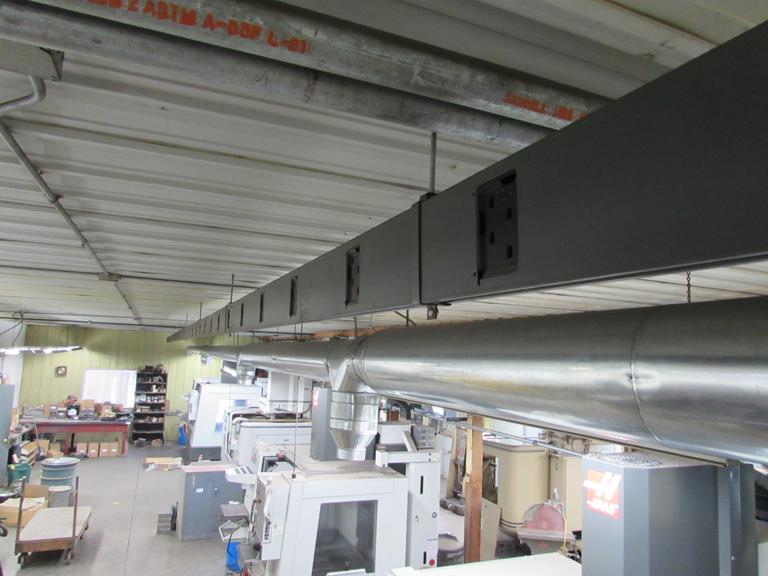I posted on last week's photo fun some quick progress shots of my new Altoona Model Works car shop that I am currently building. This will be a replacement for the one that has been on my layout for about 5 years now. It wasn't long after I had the original on the layout that I wished I opted for the extended version with the machine shop side extension. I will probably sell the original one at some point.
I got the 32" single-ended version in 3 rail with the machine shop extension and the roll-up doors. I ordered the steam heat kit but this time around I did not order the lighting kit. His lighting kit is nice but I felt like building my own. The kit is nice and safely packed when it shows up:
I sometimes do things backwards. I probably should have primed the outer walls first but the pre-cut masks he sends along makes painting easy no matter what side you do first. I took advantage of some rare nice weather to bomb the walls with Rustoleum 2X Primer outside.
I did some initial mock-up to check some of the fit and plan for setting the machine shop walls. You have at least a couple options for setting them. The end walls for the main building are now urethane like the rest of the kit. My original had Hydrocal end walls.
At this point I decided to extend the concrete pad for the shop to give me a nice paved area for junk piles, etc. I doweled a new piece of 1/2" MDF to extend it to the full length of the building.
Here is the machine shop extension walls propped up for testing purposes. Not sure where that stack is going yet. You might be able to see some of the machine tool castings I have ready at the end of my bench:
Initial interior painting. It is Rustoleum 2X white primer and Tamiya Gray Green:
The brick is painted MM acrylic Oxide Red, two coats then sealed with Rustoleum Matte Clear. 'Clearing' the base brick color will keep the mortar efforts (water soluble light spackle) from dragging the brick color into the mortar. The concrete base seen standing against the wall was scribed with expansion joints and then cracks and spalls were added. I then bombed it with Rustoleum Camo Khaki which is my go-to concrete color. It covers well and takes washes and drybrushing quite nicely as it dries super flat. In this pic it has an initial black tube acrylic wash:
Before I could start gluing the walls to the base, I needed to add the rails to the base. AMW can cut the base for different types of track and mine was cut for Atlas rails. I couldn't stand the thought of wrecking brand new Atlas 40" track sections so I decided to experiment with soldering a bunch of scrap rails together to make some 33" long runs to embed in the base. I trimmed and squared a bunch of scrap rails and arranged the random-length pieces I had to make up rail sections a little longer than the length needed. I made a quick and dirty soldering jig to keep the rails butted up tight and used a 60W iron and plumber's flux to solder the sections together:
The joints were really not too awful bad!
I did a bit more weathering and distressing after gluing the rails in. I use acrylic washes mostly using cheap tube acrylics. I airbrushed a stripe of Grimy Blacks along the rails. I experimented with making oil and grease spots along the rails. The floor drains and sewer caps are from Scale City and Berkshire Valley.
I tend to like working fast when it comes time to assembly. I scuff sanded all the urethane surfaces that were to be glued. I used a combination of medium set thick CA and E6000/Goop to set the walls. Bob does a nice job keeping all his parts square so there is minimal adjusting at this stage. I set the end wall first and made sure it landed where it needed to be since it would be the reference for the rest of the assembly. The idea of using CA and Goop in combo is that I can 'zap' the CA with accelerator once I have a wall set and rely on the CA holding it as the Goop (or E6000) cures. This structure is pretty square and sound and didn't need any mechanical assistance for the joints. Sometimes I will drill through joints and set a brass rod dipped in CA and trimmed if I think it needs it. I will do it for the trusses I need to set later.
If you noticed, I mortared all the brick face before assembling. I like to bomb a little clear matte spray over every step in brick painting. I shoot the base color on, clear it, do the mortar with cheap lightweight water-based spackle, shoot clear over everything again, do touch-up and highlights, etc., clear it once more then move onto final washes, etc.
Here's the initial setup of the machine shop walls. I set them up the way he shows in his instructions with only 4 windows plugged. You have the option of setting it so 5 windows are covered. I had to trim the walls a bit during fit-up for this arrangement.
Here's a peek into the machine shop extension after initial painting:
A quick shot of the roll-up door castings. I didn't want to do the wooden doors on this one.

























